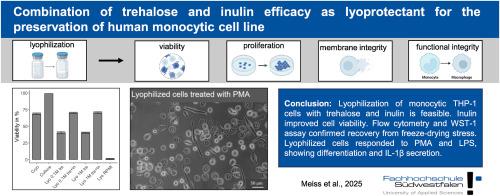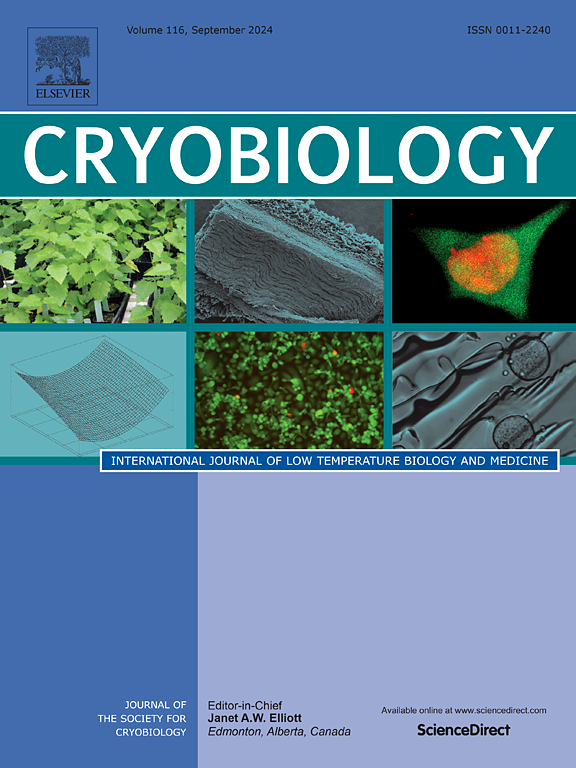Combination of trehalose and inulin efficacy as lyoprotectant for the preservation of human monocytic cell line
IF 2.1
3区 生物学
Q2 BIOLOGY
引用次数: 0
Abstract
Traditional cell cryopreservation is expensive and logistically complex, and it necessitates a constant cold chain [44,57]. Lyophilization presents an alluring substitute, so long as the right lyoprotectants are applied to preserve cell integrity [23,40,44,52]. This study examined whether the human THP-1 mononuclear cell line's viability and function are maintained during the lyophilization process when trehalose and inulin are combined as a lyoprotectant. Cell survival, membrane integrity, metabolic activity, and functional responsiveness (differentiation and cytokine secretion) were assessed after THP-1 cells were processed in various lyophilization conditions (trehalose alone versus trehalose in combination with inulin). The reference cells were cryopreserved cells. Following rehydration, the vitality of cells lyophilized in a mixture containing trehalose and inulin was comparable to that of cryopreserved cells. After a recovery period in culture, the cell membranes regained their integrity, despite being temporarily permeable right after rehydration. Additionally, the inclusion of inulin helped to reduce the residual moisture content and increase the stability of the lyophilizates, while also preserving metabolic activities and the ability to differentiate (including IL-1β release after stimulus). Trehalose and inulin work well together as a lyoprotectant, lowering the stress that THP-1 cells experience during the lyophilization process. Therefore, this approach may be a practical and affordable substitute for traditional cryopreservation, maintaining the cells' stability and activity even after extended storage.

海藻糖与菊糖联合作为冻融保护剂对人单核细胞系的保存效果
传统的细胞冷冻保存成本高,物流复杂,并且需要持续的冷链[44,57]。冻干是一种诱人的替代方法,只要使用合适的冻干保护剂来保持细胞的完整性[23,40,44,52]。本研究考察海藻糖和菊粉作为冻干保护剂联合使用时,人THP-1单核细胞系在冻干过程中是否能维持其活力和功能。在不同冻干条件下(海藻糖单独与海藻糖与菊粉联合)处理THP-1细胞后,评估细胞存活率、膜完整性、代谢活性和功能反应性(分化和细胞因子分泌)。参比细胞为冷冻保存细胞。再水化后,在含有海藻糖和菊粉的混合物中冻干的细胞的活力与冷冻保存的细胞相当。经过一段时间的恢复培养,细胞膜恢复了其完整性,尽管在补液后暂时具有渗透性。此外,菊粉的加入有助于减少剩余水分含量,提高冻干物的稳定性,同时保持代谢活性和分化能力(包括刺激后IL-1β的释放)。海藻糖和菊糖作为冻干保护剂一起工作,降低THP-1细胞在冻干过程中所经历的压力。因此,这种方法可能是传统冷冻保存的一种实用且经济的替代品,即使在延长储存后也能保持细胞的稳定性和活性。
本文章由计算机程序翻译,如有差异,请以英文原文为准。
求助全文
约1分钟内获得全文
求助全文
来源期刊

Cryobiology
生物-生理学
CiteScore
5.40
自引率
7.40%
发文量
71
审稿时长
56 days
期刊介绍:
Cryobiology: International Journal of Low Temperature Biology and Medicine publishes research articles on all aspects of low temperature biology and medicine.
Research Areas include:
• Cryoprotective additives and their pharmacological actions
• Cryosurgery
• Freeze-drying
• Freezing
• Frost hardiness in plants
• Hibernation
• Hypothermia
• Medical applications of reduced temperature
• Perfusion of organs
• All pertinent methodologies
Cryobiology is the official journal of the Society for Cryobiology.
 求助内容:
求助内容: 应助结果提醒方式:
应助结果提醒方式:


